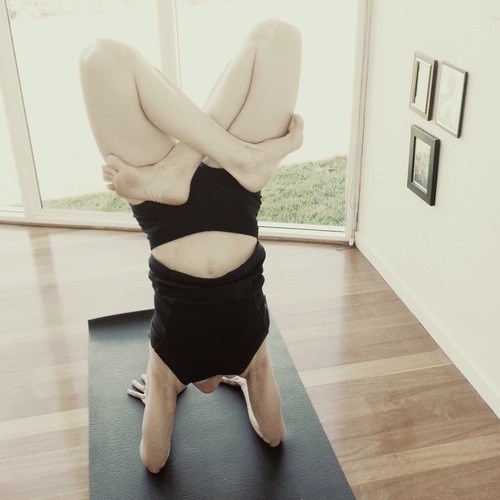Balance, it's a relationship thing.

This came up the other day when I was teaching headstand to someone for the first time. But really the keys to successful balancing whether on two feet, or one foot, on your hands or your head, are all the same. Shifting it out an octave we balance relationships, work, life, again the same principles apply.
So coming back to our body. We learnt to balance on two feet when we were about one. We have been doing it for so long the neural pathways are forged and we have forgotten the learning process. Generally we learnt with our feet under our hips, and mostly in two planes - forward and back, with swinging, climbing, tumbling, jumping etc all helping to cement our awareness of where we are in space.
Balance is not a stationary place where there is no movement. It is not an end goal, a perfect position to attain. This is why I call it a relationship. It is between the front and the back, left and right, inner and outer, gravity and grace, the past and the future. We exist in duality (until we transcend into unity). In the yoga tradition this is called Prakriti. Here we have the three gunas - Rajas or energy, Tamas or inertia and heaviness, and Sattva which is harmony, in constant motion, like the game Rock Paper Scissors. As soon as one gets on top, the next one comes along and changes everything. Cycles can turn quickly or may take eons, but we know nothing lasts and everything changes.
We really don’t give too much thought to how we balance….. Until it is challenged. We can do this deliberately in our yoga practice. We start with standard poses with two feet on the floor. Our brain and feet work hard to hold us steady. Standing on one foot is more challenging still as more of the body is called in to keep the posture steady. Challenging ourselves further we try balancing on parts other than the feet - the buttocks, perhaps, or full inversions on forearms, head or hands.
If you close your eyes as you stand on two feet and take your attention to your feet against the floor, you will notice continual, minute adjustments made as your body works to hold itself steady. Learning to take headstand or handstand realise that the body needs to relearn this pattern in another form.
Some points to successful balancing:
-
Minimise physical resistance by opening key areas like hamstrings and shoulders so that you can lift away from the floor, or get your body into the optimal position.
-
See it in your minds eye, visualise yourself in the posture with ease.
-
Drop your attention into the present moment. A wandering mind will not be able to balance.
-
Move from and around your centre. Slow mindful movements. There is no place for forcing or
rushing.
-
Breathe. Holding the breath indicates tension in the body. Breath awareness keeps the mind
focused and present and can help to keep the body buoyant and light.
-
Use an appropriate drishti or eye focal point. Looking far into the distance, or eyes closed and
you are making your job twice as hard. Find a point close, on the floor or wall, that is in the
direction of your movement, and soften your gaze.
-
No rush and no expectation. If you don’t get it the first go give it two more tries then move on.
Remember your yoga practice is a journey where we also practice surrender and letting go.
-
Practice with joy, not fear or anxiety. If you are not enjoying it, don’t do it.
-
Learn to BE, not DO.
While we are operating in this realm of duality we will always be shifting in terms of balance. Sometimes with ease, sometimes with resistance. Take away the struggle and it is there. It was
always there. The Universe holds this truth, as It operates in unity. In the yoga tradition we call this Purusha. It is impossible for the Universe to be out of balance, it simply IS.
Now, let your yoga practice take you there.